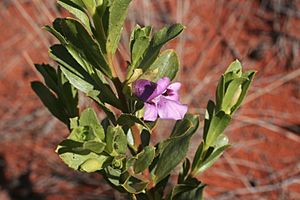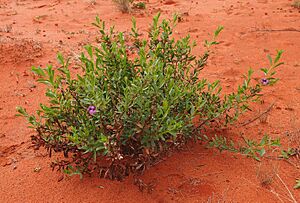Eremophila willsii facts for kids
Quick facts for kids Eremophila willsii |
|
|---|---|
 |
|
| Scientific classification | |
| Genus: |
Eremophila (plant)
|
| Species: |
willsii
|
| Synonyms | |
|
|
Eremophila willsii is a beautiful flowering plant that belongs to the figwort family, called Scrophulariaceae. It grows only in Australia, which means it is endemic there. This plant is an upright shrub with bright green leaves that often have jagged edges. Its flowers are usually pink or deep pinkish-purple. You can mostly find Eremophila willsii growing in deep sand in Western Australia, the Northern Territory, and South Australia.
Contents
What Eremophila willsii Looks Like
Eremophila willsii is an upright shrub. Sometimes it grows in a compact, bushy shape, and other times it is more open and spindly. It can grow to be about 0.45 to 1.5 meters (1.5 to 5 feet) tall. Its branches are often sticky because they have a lot of resin on them.
The leaves grow one after another along the branches. They can be smooth (without hairs) or hairy, depending on the type of plant. Most leaves are about 10-30 millimeters (0.4-1.2 inches) long and 4-11 millimeters (0.16-0.43 inches) wide. They often have jagged edges, like a saw. The shape of the leaves can vary a lot. They are usually narrow and oval-shaped, sometimes clustered together, and other times spread out.
The flowers grow alone or in groups of up to four where the leaves meet the stem. They sit on stalks that are usually 5.5-15 millimeters (0.22-0.59 inches) long and often very hairy. There are five overlapping, egg-shaped to lance-shaped sepals, which are mostly 10-15 millimeters (0.39-0.59 inches) long. These sepals can also be hairy or smooth.
The petals are 17-28 millimeters (0.67-1.1 inches) long. They are joined at the bottom to form a tube. This petal tube is pink, deep pinkish-purple, or lilac-colored. Inside the tube, there are two noticeable dark purple bands. The outside of the tube and its petal parts are somewhat hairy. However, the inside of the petal parts is smooth, and the inside of the tube is full of long, soft hairs. The four stamens, which are the parts that produce pollen, are completely hidden inside the petal tube.
Eremophila willsii flowers from May to October. After flowering, it produces fruits. These fruits are narrow, oval-shaped to cone-shaped, with a pointed end. They are about 3.5-4.5 millimeters (0.14-0.18 inches) long and have a hairy surface.
How it Got its Name
This plant was first officially described in 1862 by Ferdinand von Mueller. He was a government botanist in Victoria, Australia. His description was based on a plant sample collected by John McDouall Stuart near the Finke River.
The plant's specific name, willsii, was given to honor William John Wills. He was the second-in-command of the famous but tragic Burke and Wills expedition. Sadly, he lost his life during that journey the year before the plant was named.
There are two main types, or subspecies, of Eremophila willsii:
- Eremophila willsii subsp. willsii: This type has branches, leaves, and sepals that are covered with tiny, sticky hairs called glandular hairs.
- Eremophila willsii subsp. integrifolia: This type has branches and the outside of its sepals that are either smooth or only slightly hairy. Its leaves are also smooth.
Where Does it Grow?
The subspecies willsii grows in the southwest part of the Northern Territory and nearby areas of South Australia. It likes to grow on red sand plains, sand dunes, and the low areas between them. You can also find it in the Central Ranges area of Western Australia.
The subspecies integrifolia is found across a wider area. It grows in the sand dune systems of the southern Northern Territory, western South Australia, and in the Central Ranges, Gibson Desert, and Great Victoria Desert regions of Western Australia. There is also one record of it growing in far western Queensland.
Protecting the Plant
Both types of Eremophila willsii are considered "not threatened" by the Western Australian Department of Parks and Wildlife. The Northern Territory Government also lists them as being of "Least Concern" under their conservation act. This means they are not currently at risk of disappearing.
Growing Eremophila willsii
Eremophila willsii can sometimes be a thin, spindly shrub. However, its amazing flowers make up for its shape. You can grow new plants from cuttings placed in sand. It helps if the sand is warm at the bottom and gets occasional misting.
This plant grows best in soil that drains water well and in a sunny spot. It rarely needs watering, even during long dry periods. It can also handle moderate frost, meaning it can survive some cold temperatures.


